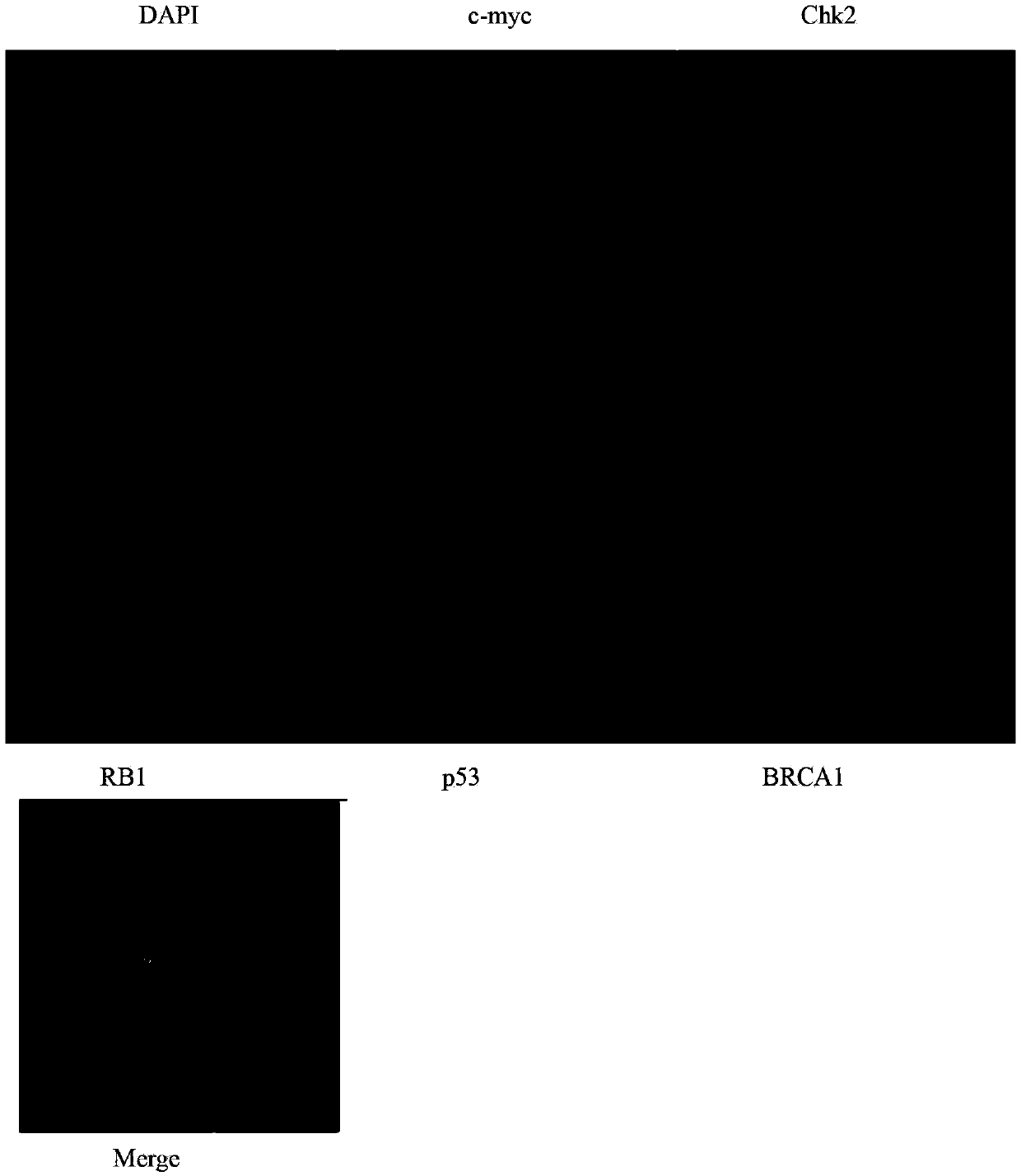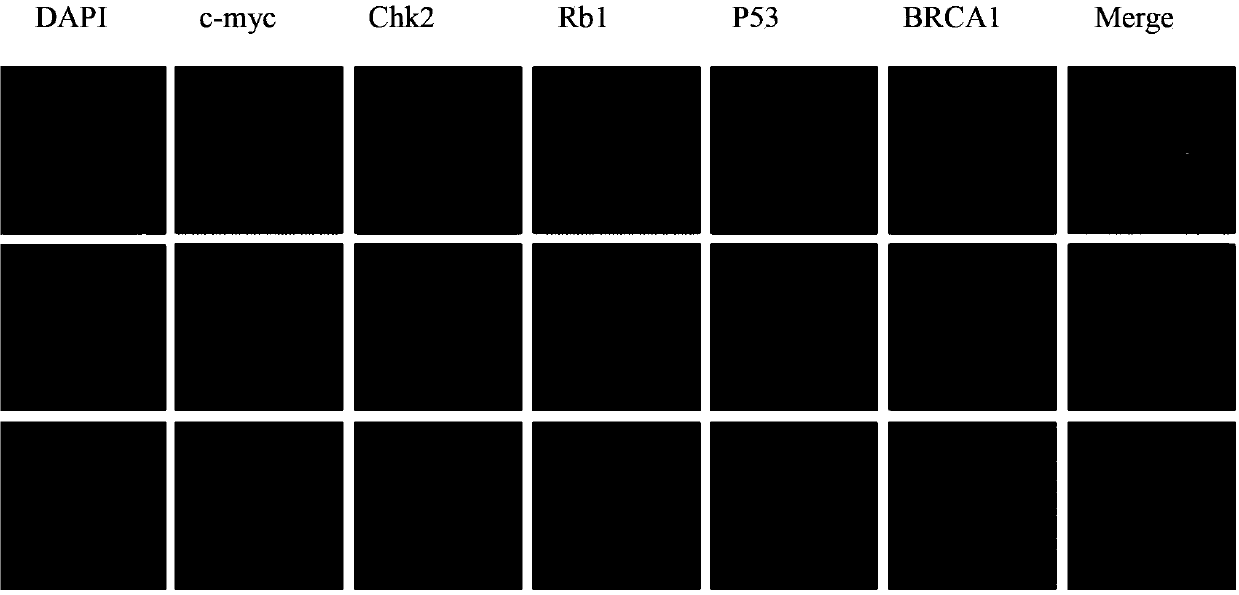Gene probe composition and kit for detecting epithelial ovarian cancer
A gene probe and composition technology, applied in the field of gene probe composition and kit for detecting epithelial ovarian cancer, can solve the problem of low incidence
- Summary
- Abstract
- Description
- Claims
- Application Information
AI Technical Summary
Problems solved by technology
Method used
Image
Examples
Embodiment 1
[0090] Embodiment 1: The preparation method of BRCA1 gene probe comprises the following steps:
[0091] 1. Clone screening: The BRCA1 gene is located in the 21.2-21.31 segment of the long arm of human chromosome 17 (17q21.2-q21.31). Search for all clones containing the BRCA1 gene in the UCSCgenomebrowser, NCBICloneRegistry, and EnsemblGenomeBrowser databases, and screen out the clones containing the gene. The optimal clone is numbered RP11-831F13 (as shown in Table 1).
[0092] 2. Cloning culture and identification: purchase clone RP11-831F13 (Invitrogen, USA), take 8 microliters of clone bacteria liquid and add it to 5 milliliters of LB liquid medium containing chloramphenicol resistance, shake and activate at 37°C for 12 hours ; Then add all the bacterial liquid to 450 ml of LB liquid medium containing chloramphenicol resistance, and collect the bacterial liquid after shaking and culturing at 37° C. for 12 hours. Use upstream primer: TAGGGCTGGAAGCACAGAGT (SEQ ID NO: 9), dow...
Embodiment 2
[0119] Embodiment 2: the preparation method of c-myc, Rb1, Chk2, p53, BRCA1 gene probe composition, comprises the following steps
[0120] 1. Clone screening:
[0121] By searching UCSCgenomebrowser, NCBICloneRegistry, EnsemblGenomeBrowser and other databases respectively contain all clones of c-myc, Rb1, Chk2, p53, BRCA1 genes. The optimal clones containing the gene were screened out, and the numbers were: RP11-440N18, RP11-305D15, RP11-73I4, RP11-1081A10, RP11-831F13. (As shown in table 2)
[0122] 2. Cloning culture and identification: Purchase the clone according to the clone number (Invitrogen, USA), take 8 microliters of the clone bacteria solution and add it to 5 milliliters of chloramphenicol-resistant LB liquid medium, shake and activate at 37°C for 12 hours ; Then add all the bacterial liquid to 450 ml of LB liquid medium containing chloramphenicol resistance, and collect the bacterial liquid after shaking and culturing at 37° C. for 12 hours. The bacteria liquid ...
Embodiment 3
[0160] Example 3: A fluorescent in situ hybridization detection kit for epithelial ovarian cancer (50 servings), the composition is as follows:
[0161] 1) Fluorescence-labeled probe set hybridization mixture 100 microliters; 1 tube
[0162] 2) 500 microliters of DAPI counterstaining solution; 1 tube
[0163] 3) 20ml of 20XSSPE washing solution; 1 bottle
[0164] 4) 1 instruction manual.
[0165] Wherein the concentration of the c-myc gene probe in the hybridization mixture of the fluorescently labeled probe group is: 4ng / μl, the concentration of the Rb1 gene probe is: 4ng / μl, the concentration of the Chk2 gene probe is: 4ng / μl, and the concentration of the p53 gene probe 4ng / μl, BRCA1 gene probe concentration: 4ng / μl.
PUM
| Property | Measurement | Unit |
|---|---|---|
| molecular weight | aaaaa | aaaaa |
Abstract
Description
Claims
Application Information
 Login to View More
Login to View More - R&D
- Intellectual Property
- Life Sciences
- Materials
- Tech Scout
- Unparalleled Data Quality
- Higher Quality Content
- 60% Fewer Hallucinations
Browse by: Latest US Patents, China's latest patents, Technical Efficacy Thesaurus, Application Domain, Technology Topic, Popular Technical Reports.
© 2025 PatSnap. All rights reserved.Legal|Privacy policy|Modern Slavery Act Transparency Statement|Sitemap|About US| Contact US: help@patsnap.com



